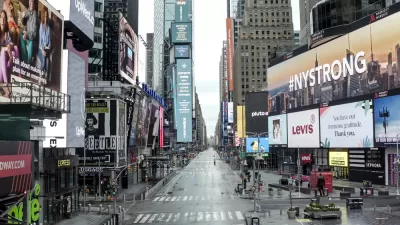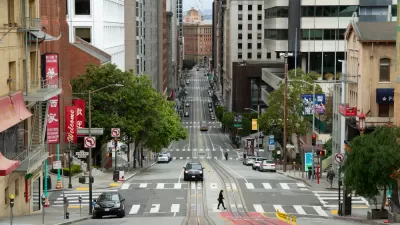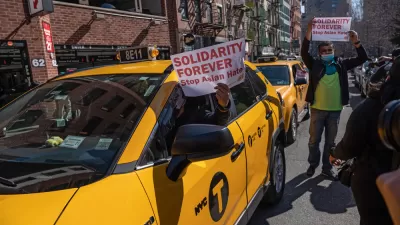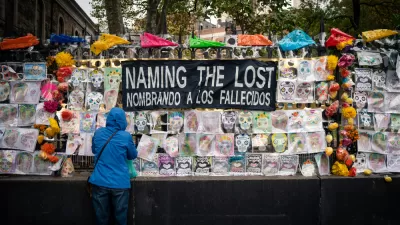The initial shocks of the Covid 19 pandemic have become more persistent, and it’s time to start wondering what comes next for the communities on either side of the changes.

Thomas B. Edsall wrote the most talked about and potentially divisive article of the past week for the New York Times, predicting an “urban doom loop” that means the recovery of urban core areas over the past 30 years is coming to a close as a result of the Covid 19 pandemic.
It’s the latest foray into the discussion of an “urban exodus” that dominated urbanism media in the early months of 2020, though were the discussions of 2020 happened rapidly, with sirens wailing in the background, Edsall’s article now has the benefit of three years of evidence, aggregation, and a collective settling-in—to the “new normal” of post-pandemic, endemic Covid 19 and all the changes that means.
Edsall’s examination of the ills facing cities after three years of Covid 19 starts with a working paper examining the remote work “revolution,” written by Stijn Van Nieuwerburghand published in November 2022. In the paper, Nieuwerburghand argues that the last 30 years were a “golden era” for large cities: ‘A virtuous cycle of improving amenities (educational and cultural institutions, entertainment, low crime) and job opportunities attracted employers, employees, young and old, to cities.’
Now, however, Covid-induced travel patterns, out of the city and into suburbs, have taken a more persistent pattern. “In Van Nieuwerburgh’s view — and that of many of his colleagues — what seemed like a transitory step to avoid infection has become a major force driving the future direction of urban America,” writes Edsall.
Scholars are increasingly voicing concern that the shift to working from home, spurred by the Covid pandemic, will bring the three-decade renaissance of major cities to a halt, setting off an era of urban decay. They cite an exodus of the affluent, a surge in vacant offices and storefronts, and the prospect of declining property taxes and public transit revenues.
A review of the leading research and rhetoric on the subject follows, until Edsall arrives on the research that coined the term “urban doom loop.” Another working paper, this one written by Arpit Gupta of N.Y.U.’s Stern School of Business, Vrinda Mittal of the Columbia Business School, and Van Nieuwerburgh and published in September 2022, predicts disaster for cities. Here, Edsall summarizes the “urban doom loop”:
As major cities are caught in a downward fiscal spiral, the forces driving the process will be felt in varying stages. The loss of transit ridership fares and sales taxes is immediate; declining residential, retail and office property taxes will take longer to phase in as new appraisals are performed; drops in income tax revenues will occur as families moving outside city limits change their legal residence.
Experts that don’t share this pessimistic outlook, including Edward Glaeser, who wrote arguably the definitive tome on the golden years of cities, and Richard Florida are cited toward the end of the long article below.
“There is reason for both apprehension and hope. Cities across time have proved to be remarkably resilient and have survived infectious diseases such as bubonic plague, cholera, smallpox and polio,” writes Edsall to conclude. “[T]he urbanization process is quite likely to continue into the foreseeable future. There appears to be no alternative, so we will have to make it work.”
FULL STORY: How a ‘Golden Era for Large Cities’ Might Be Turning Into an ‘Urban Doom Loop’

Florida Considers Legalizing ADUs
Current state law allows — but doesn’t require — cities to permit accessory dwelling units in single-family residential neighborhoods.

Manufactured Crisis: Losing the Nation’s Largest Source of Unsubsidized Affordable Housing
Manufactured housing communities have long been an affordable housing option for millions of people living in the U.S., but that affordability is disappearing rapidly. How did we get here?

Research Shows More Roads = More Driving
A national study shows, once again, that increasing road supply induces additional vehicle travel, particularly over the long run.

EV Chargers Now Outnumber Gas Pumps by Nearly 50% in California
Fast chargers still lag behind amidst rapid growth.

Affordable Housing Renovations Halt Mid-Air Amidst DOGE Clawbacks
HUD may rescind over a billion dollars earmarked for green building upgrades.

Has Anyone at USDOT Read Donald Shoup?
USDOT employees, who are required to go back to the office, will receive free parking at the agency’s D.C. offices — flying in the face of a growing research body that calls for pricing parking at its real value.
Urban Design for Planners 1: Software Tools
This six-course series explores essential urban design concepts using open source software and equips planners with the tools they need to participate fully in the urban design process.
Planning for Universal Design
Learn the tools for implementing Universal Design in planning regulations.
City of Moreno Valley
Institute for Housing and Urban Development Studies (IHS)
City of Grandview
Harvard GSD Executive Education
NYU Wagner Graduate School of Public Service
City of Cambridge, Maryland
Newport County Development Council: Connect Greater Newport





























